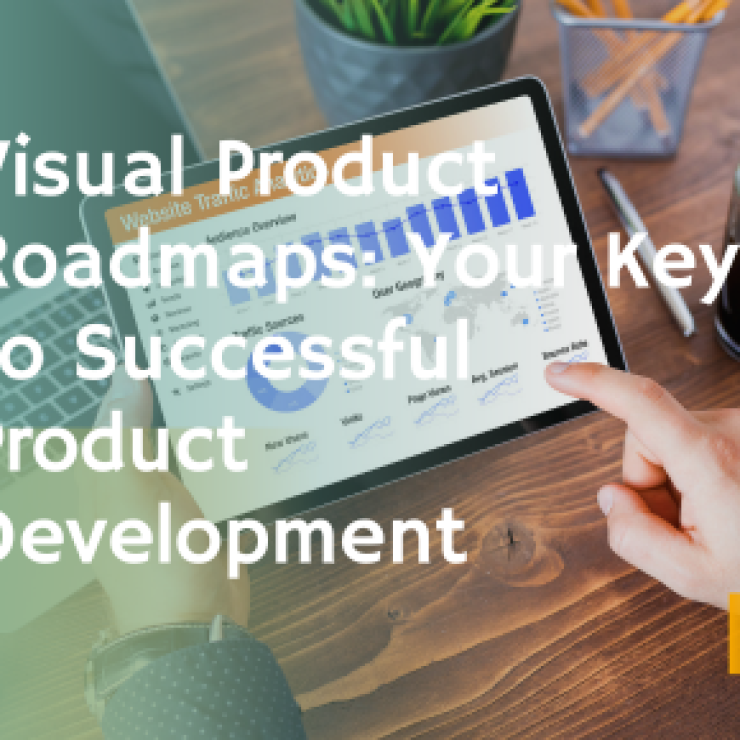In the ever-evolving realm of enterprise management, one tool reigns supreme in guiding organizations through their journey of transformation: the Enterprise Architecture Roadmap.
This strategic tool ensures a clear path for organizations to realize their business goals and objectives, ensuring successful transitions from current to future state. Today, we delve into the intriguing world of the Enterprise Architecture Roadmap.
What is an Enterprise Architecture Roadmap?
An Enterprise Architecture Roadmap is a strategic planning tool that presents a holistic view of an organization’s current state, future state, and the path to transition from one state to another.
It visualizes and aligns the organization’s strategic objectives with its information technology (IT) capabilities, business processes, systems, and infrastructure. By doing so, it provides a unified perspective on the interdependencies and changes that need to occur for the organization to achieve its strategic vision.
While the contents can vary based on the organization’s unique needs, a typical Enterprise Architecture Roadmap includes:
- A depiction of the current enterprise architecture
- A clear vision of the desired future state
- Identification of gaps between the current and future state
- Strategic initiatives to address these gaps
- A timeline outlining the progression of these initiatives
Why Do You Need an Enterprise Architecture Roadmap?
In today’s business landscape characterized by constant evolution and disruption, maintaining a competitive edge requires an agile, adaptive, and forward-looking strategy. That’s where the Enterprise Architecture Roadmap becomes indispensable. Let’s explore why this tool is an absolute necessity for organizations:
1. Strategic Alignment:
The first and foremost reason you need an Enterprise Architecture Roadmap is to achieve strategic alignment. The roadmap ensures that your business strategy and IT strategy walk hand-in-hand.
It allows you to align your IT capabilities, business processes, and organizational structure to your strategic objectives. This way, every investment and change in the IT landscape directly contributes to achieving the organization’s goals.
2. Structured Change Management:
The roadmap isn’t just a static depiction of the organization’s present and future states; it’s a dynamic tool for managing change. As your business grows, you’ll need to make changes to your architecture—introducing new systems, upgrading existing ones, or retiring obsolete ones.
The Enterprise Architecture Roadmap helps you plan these changes strategically, defining what needs to change, when it should change, and how to manage the change, reducing the risks associated with transformation.
3. Risk Management:
Every change comes with a degree of risk. Without a clear understanding of your enterprise architecture and the interdependencies within it, changes can have unforeseen impacts, leading to system disruptions, operational inefficiencies, or even compliance issues.
The Enterprise Architecture Roadmap helps you anticipate these risks by providing a comprehensive view of your architecture and the impact of proposed changes, allowing you to manage these risks proactively.
4. Investment Optimization:
With limited resources, it’s crucial that you invest where it matters most. The Enterprise Architecture Roadmap provides visibility into the alignment between your IT investments and your strategic objectives.
It helps identify where resources are needed most and where they can be reallocated for better results, ensuring that every dollar spent advances your strategic objectives.
5. Communication:
Finally, the Enterprise Architecture Roadmap serves as a powerful communication tool. It provides a clear, visual representation of your strategic plan, making it easier to explain to stakeholders.
It helps win their buy-in and ensures that everyone in the organization understands the direction you’re heading and their role in getting there.
Advantages of using an Enterprise Architecture Roadmap
Adopting an Enterprise Architecture Roadmap comes with numerous advantages, enhancing not just your IT operations but also your overall business strategy and success. Here are some key benefits:
1. Improved Decision-Making:
With a comprehensive understanding of the current architecture, the future state, and the path to get there, decision-makers are well-equipped to make strategic decisions.
The roadmap provides insights into how IT capabilities, business processes, and systems interact and contribute to business objectives, thereby facilitating more informed decision-making.
2. Enhanced Business Agility:
A well-crafted roadmap supports agile operations by providing a flexible plan for managing change. As business environments evolve, organizations need to respond swiftly and effectively to these changes.
An Enterprise Architecture Roadmap enables you to adapt your strategy and operations to align with changes in market conditions, customer needs, and technology trends.
3. Reduced Redundancy:
The roadmap can identify overlapping systems and processes, leading to potential cost savings and efficiency gains. By giving a bird’s eye view of the organization’s architecture, you can pinpoint areas of redundancy and eliminate them, optimizing resource allocation and streamlining operations.
4. Increased Business-IT Alignment:
The roadmap improves the alignment between business and IT. With a clear understanding of how IT capabilities support business objectives, you can ensure that every IT investment and initiative aligns with and contributes to the business strategy.
This improved alignment enhances business performance and competitiveness.
5. Enhanced Stakeholder Engagement:
The roadmap serves as a communication tool, fostering better stakeholder engagement. By communicating the strategic plan and its benefits to various stakeholders, you can build buy-in and commitment.
The visual nature of the roadmap makes it easier for stakeholders to understand the strategic vision and the path to achieve it, promoting their active participation in the journey.
How do you Develop an Enterprise Architecture Roadmap?
Creating an Enterprise Architecture Roadmap involves several steps. While the specific process might vary slightly depending on the nature and needs of your organization, here is a generalized approach to guide you:
1. Define the Scope:
The first step is to define the scope of the roadmap. Are you focusing on the enterprise-wide architecture or a specific domain such as business, data, applications, or technology? Your scope will set the boundaries for what is to be included in the roadmap.
2. Understand the Current State:
The next step is to document your current enterprise architecture. This includes detailing your existing business processes, applications, data, and technology infrastructure. This baseline will give you an understanding of your organization’s strengths, weaknesses, opportunities, and threats (SWOT).
3. Envision the Future State:
Once you have a solid understanding of the current state, turn your gaze to the future. What are your organization’s strategic objectives? How should your enterprise architecture evolve to support these objectives? What will the future state of your business processes, applications, data, and technology look like? The future state represents the strategic vision of your organization.
4. Identify Gaps:
With the current and future states laid out, you can now identify the gaps. These are the changes you need to make in your enterprise architecture to transition from the current to the future state. This could involve introducing new systems, upgrading existing ones, changing business processes, or reorganizing your IT infrastructure.
5. Develop the Roadmap:
Now, you need to plan how to close these gaps. This is where the roadmap comes into play. For each gap, you should identify strategic initiatives that can help bridge it. These initiatives should be prioritized based on their alignment with strategic objectives, and a timeline should be set for their implementation. Your roadmap should include key milestones to help track progress.
6. Review and Refine:
The final step is to continuously review and refine your roadmap. A roadmap isn’t a one-and-done document but a living tool that should evolve with your organization. As your strategic objectives change or as you achieve milestones, you should revisit and adjust your roadmap accordingly.
By following these steps, you can develop a strategic Enterprise Architecture Roadmap that not only guides your organization towards its future state but also enables it to navigate the changes along the way.
Tips for Your Enterprise Architecture Roadmap
An enterprise architecture roadmap is a strategic plan that outlines the direction and goals of an organization’s enterprise architecture initiatives. It helps guide the development, implementation, and evolution of the enterprise architecture to support the organization’s business objectives.
Here are some tips to consider when creating your enterprise architecture roadmap:
Define clear business objectives:
Start by understanding the business objectives and goals of your organization. Align your enterprise architecture roadmap with these objectives to ensure that your efforts directly contribute to the success of the business.
Conduct a current-state assessment:
Assess your organization’s existing architecture landscape, including systems, applications, processes, and data. Identify strengths, weaknesses, and areas for improvement. This assessment will help you understand the starting point for your roadmap and prioritize areas that require attention.
Establish a target-state vision:
Define a target-state vision for your enterprise architecture. Consider factors such as business capabilities, technology trends, industry standards, and regulatory requirements. This vision will serve as a guide for the development of your roadmap and help create a shared understanding among stakeholders.
Prioritize initiatives:
Identify key initiatives that will bridge the gap between the current-state and target-state architecture. Prioritize these initiatives based on their potential business impact, feasibility, and alignment with strategic objectives. Consider dependencies, risks, and resource constraints when prioritizing your initiatives.
Develop a phased approach:
Break down your roadmap into logical phases or increments. Each phase should deliver tangible value and be manageable in terms of scope and resources. Consider dependencies between initiatives and ensure that each phase builds upon the previous ones, leading towards the target-state architecture.
Engage stakeholders:
Involve key stakeholders throughout the development and implementation of your roadmap. Seek their input, address their concerns, and ensure their buy-in. Collaboration and communication are crucial for successful enterprise architecture initiatives.
Monitor and adjust:
Regularly review and update your roadmap to reflect changes in business objectives, technology landscape, and organizational priorities. Monitor the progress of your initiatives, measure their impact, and make adjustments as necessary. Enterprise architecture is an iterative process that should adapt to evolving business needs.
Leverage industry best practices:
Stay informed about industry trends, frameworks, and best practices in enterprise architecture. These resources can provide valuable guidance and insights into effective approaches for architecture planning, governance, and implementation.
Establish governance mechanisms:
Develop governance mechanisms to ensure that your enterprise architecture initiatives align with strategic objectives, adhere to standards, and effectively manage risks. Establish an architecture review board or similar body to provide oversight and decision-making authority.
Communicate and educate:
Effective communication is key to gaining support for your enterprise architecture roadmap. Clearly articulate the benefits, outcomes, and value proposition of your initiatives to stakeholders at all levels of the organization.
Educate employees about the importance of enterprise architecture and how it aligns with the organization’s goals.
The Enterprise Architecture Roadmap: Well Worth the Effort
In conclusion, the Enterprise Architecture Roadmap is an invaluable tool in the arsenal of modern enterprises. It offers a clear, strategic, and flexible plan for navigating the future, ensuring that organizations can manage change effectively and realize their business goals.
“Discover how an enterprise architecture roadmap can guide your organization towards a successful future by aligning business objectives with technology investments.”
Although it requires significant effort to develop and maintain, the benefits—enhanced decision-making, improved agility, reduced redundancy, and better stakeholder engagement—make it well worth the effort. So embark on the journey of developing your Enterprise Architecture Roadmap today. Your future self will thank you.




